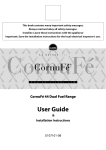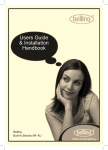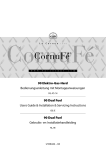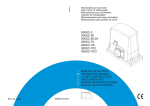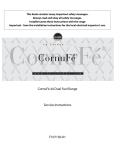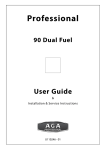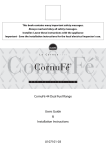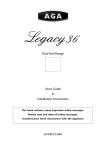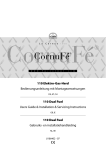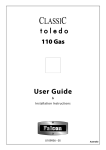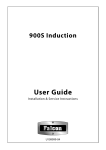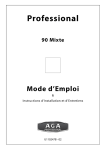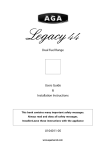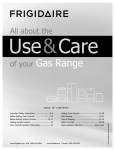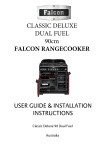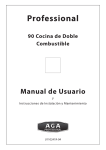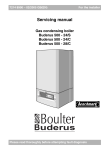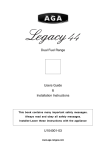Download Installation & User Guide (90 “Albertine”)
Transcript
AlberTine 36 Dual Fuel Range AlberTine AlberTine User Guide & Installation & Service Instructions U109956-07 Contents 1. Important Safety Information 1 2. Range Overview 5 3. Multi-function Oven cooking guide 12 4. Cleaning Your Range 14 5. Troubleshooting 16 6.Installation 19 7. Conversion to LP Gas 34 8. Service and Parts 38 9. Circuit Diagram 39 10. Technical Data 40 11.Warranty 41 1. Important Safety Information Have your appliance properly installed and grounded by a qualified technician in accordance with the National Electrical Code ANSI/NFPA No. 70 – latest edition, and local code requirements. In Canada, electrical grounding must be in accordance with the current CSA C22.1 Canadian Electrical Code Part 1 and/or local codes. they may burn, melt or soften if left too close to a vent or a lighted burner. Storage should not be installed directly above a range. If anything is stored above the range, it should be limited to infrequently used items, which can be safely stored in an area subjected to heat from a range. Temperatures may be unsafe for some items such as volatile liquids, cleaners or aerosol sprays. Install only as described in the installation section of this book. Ask your dealer to recommend a qualified technician and an authorized repair service. Know how to disconnect the power to the range at the circuit breaker or fuse box in case of an emergency. Destroy the carton and plastic bags after unpacking the range. Never allow children to play with packaging material. Never use this appliance as a space heater to heat or warm the room. Doing so may result in overheating of the oven and control knobs. The anti-tip device supplied with this range must be installed when the appliance is installed. This will reduce risk of tipping of the appliance from abnormal usage or by excessive loading of the oven door or storage drawer. Never cover any slots, holes or passages in the oven bottom or cover an entire rack with materials such as aluminum foil. Doing so blocks air flow through the oven. Aluminum foil linings may also trap heat causing a fire hazard. To avoid personal injury do not sit, stand or lean on oven doors or drawer. User servicing–Do not repair or replace any part of the appliance unless specifically recommended in this User Manual. Leaning, sitting or stepping on the doors or drawer of this range can result in serious injuries and also cause damage to the range. Do not allow anyone to climb, stand or hang on any part of the range. All other servicing should be done only by a qualified technician, this may reduce the risk of personal injury and damage to the range. In Case of Fire Never modify or alter the construction of a range by removing leveling legs, panels, wire covers, anti-tip brackets/ screws, or any other part of the product. Do not use water on grease fires. Never pick up a flaming pan. Turn the controls off. Smother a flaming pan on a cooktop burner by covering the pan completely with a well fitting lid or baking tray. If available use a multipurpose dry chemical or foamtype fire extinguisher. Do Not Leave Children Alone. Babies, toddlers and young children should not be allowed near the range at any time. They should never be allowed to sit or stand on any part of the appliance. If fire is in an oven pan, smother by closing oven door. Open doors and windows or if a hood is installed turn it on to remove smoke and odor. Do not allow children to climb or play around the range. The weight of a child on an open door may cause the range to tip, resulting in serious burns or other injury. To Prevent Fire or Smoke Damage Teach them not to play with controls or any other part of the range. Before using the range make sure all the packing materials have been removed. Never store items of interest to children in the cabinets above a range or on backguard of a range; children climbing on the range to reach them could be seriously injured. Always keep the area around the range free from combustible materials, gasoline, and other flammable vapors and liquids. If the range is installed near a window, proper precautions should be taken to prevent curtains from blowing over the burners. Do not use the oven for storage. This instruction is based on safety considerations. Flammable materials should not be stored in an oven, the range storage drawer or near the cooktop burners. This includes paper, plastic and cloth items, such as cookbooks, plasticware and towels, as well as flammable liquids. Do not store explosives, such as aerosol cans, on or near the appliance. NEVER leave any items on the range cooktop. The hot air from an oven vent may ignite flammable items and may increase pressure in closed containers, which may cause them to burst. Many aerosol-type spray cans are EXPLOSIVE when exposed to heat and may be highly flammable. Avoid their use or storage near an appliance. Flammable materials may explode and result in fire or property damage. Many plastics will burn and most are damaged by heat. Keep plastic items away from parts of the range that may become warm or hot. Do not leave plastic items on the cooktop as 1 to warn customers of potential exposures to such substances. To avoid risk of electrical shock, personal injury, or death, make sure your range has been properly grounded and always disconnect it from main power supply before servicing. This appliance contains or produces a chemical or chemicals which can cause death or serious illness and which are known to the state of California to cause cancer, birth defects or other reproductive harm. Do not touch cook top burners or areas near burners. Users of this appliance are hereby warned that the burning of gas can result in low-level exposure to some of the listed substances, including benzene, formaldehyde and soot, due primarily to the incomplete combustion of natural gas or liquid petroleum (LP) fuels. Properly adjusted burners will minimize incomplete combustion. Gas burners may be hot even if they have been off for some time. Areas near the gas burners may become hot enough to cause burns. During and after use, do not touch, or let clothing touch or other flammable materials contact the burners or areas near the burners until they have had enough time to cool. These areas include the rangetop and backguard. Exposure to these substances can also be minimized by properly venting with an open window or using a ventilation fan or hood. Watch food in the broiler carefully. Because of the high, direct heat, it is easy to burn food, and splattering grease can sometimes catch fire. To reduce the risk from substances in the fuel or from fuel combustion make sure this appliance is installed, operated, and maintained according to the instructions in this booklet. If something does catch fire, do not pour water on it, because this can splash flaming grease on you or on other parts of the kitchen. Shut the oven door and immediately turn off the broiler. Most broiler fires will suffocate themselves. If the fire persists use a fire extinguisher. Important: Never keep pet birds in the kitchen or in rooms where the fumes from the kitchen could reach. Birds have a very sensitive respiratory system. Fumes released due to overheated cooking oil, fat, margarine and overheated non-stick cookware may be harmful. DO NOT TOUCH HEATING ELEMENTS OR INTERIOR SURFACES OF OVENS. IMPORTANT: Save the installation instructions for the local electrical inspector’s use. Oven heating elements may be hot though they are dark in color. Interior surfaces of an oven may become hot enough to cause burns. During and after use, do not touch, or let clothing or other flammable materials touch heating elements or interior surfaces of oven until they have had enough time to cool. Proper Installation Be sure your appliance is properly installed and grounded by a qualified technician. Other range surfaces that may become hot enough to cause burns are the oven door and oven vent at the base of the range splashback. Conversion This appliance is supplied set for Natural gas. A conversion kit for Propane gas is supplied with the range. Wear Suitable Clothing Be sure your range is correctly adjusted by a qualified service technician or installer for the type of gas (Natural or LP) that is to be used. See the Installation section of these instructions. Never wear loose-fitting or hanging clothes while using the range. Be careful when reaching for items stored in cabinets over the cooktop. Flammable material could be ignited if brought into contact with a burner flame or hot surface and may cause severe burns. WARNING: These adjustments must be made by a qualified service technician in accordance with the manufacturer’s instructions and all codes and requirements of the authority having jurisdiction. Failure to follow these instructions could result in serious injury or property damage. The qualified agency performing this work assumes responsibility for the conversion. Use Only Dry Potholders or Oven Gloves Moist or damp potholders on hot surfaces may result in burns from steam. Never let a potholder touch hot heating elements. Do not use a towel or other bulky cloth in place of a glove. They might catch fire if they touch a hot surface. User Servicing Do not repair or replace any part of the appliance unless specifically recommended in the manual. All other servicing should be referred to a qualified technician. Use dry oven gloves when applicable – using damp gloves might result in steam burns when you touch a hot surface. Never operate the range with wet hands. Cooktop burners Important Safety Notice and Warning Quality of Flames The California Safe Drinking Water and Toxic Enforcement Act of 1986 (Proposition 65) requires the Governor of California to publish a list of substances known to the State of California to cause cancer or reproductive harm, and requires businesses On Natural Gas the burners’ flames should be a blueish color with, at most, a slight yellowish fringe. On Propane gas the flames may be “softer”. The cooktop 2 burner flames may have a slight yellowish tip. Placement of Oven Racks If the flame burns with a long white tip you should call for service. Always place oven racks in desired location while oven is cool. If rack must be moved while oven is hot, do not let potholder contact hot heating element in oven. If the flame is distorted, check that the burner head is correctly placed over the burner. Do not store items of interest to children in cabinets above a range or on the backguard of a range - MAKE SURE THE FLOW OF COMBUSTION AND VENTILATION AIR TO THE RANGE IS UNOBSTRUCTED. children climbing on the range to reach items could be seriously injured. Use the Right Size Pan WARNING! THIS APPLIANCE IS PROVIDED WITH ROLLERS TO FACILITATE MOVEMENT DURING This appliance is equipped with burners of different sizes. Use utensils with flat bottoms. Do not use unstable pans and position the handles away from the edge of the cooktop. Make sure the flames are under the pans. It’s not safe to let the flames burn up the sides of the pan; the handle may get too hot. INSTALLATION. THE RANGE SHOULD NOT BE MOVED AFTER INSTALLATION. General Safety Instructions This appliance must be installed by a competent person in accordance with the installation instructions. The installation must comply with the relevant regulations and also the local electricity supply company requirements. Proper relationship of utensil to burner will also improve efficiency. Never leave cooktop burners unattended at high settings. Pans boiling over can cause smoking and This appliance is designed for domestic cooking only. Use for any other purpose could invalidate any warranty or liability claim. greasy spills may catch on fire. Protective liners – Do not use aluminum foil to line cooktop bowls or oven bottoms. Foil liners The use of a gas cooking appliance results in the production of heat and moisture in the room in which it is installed. Make sure that the kitchen is well ventilated: keep natural ventilation holes open or install a mechanical ventilation device, (mechanical extractor hood). may result in a risk of electric shock, or fire and will damage the enamel finish. Never allow aluminum foil to contact the heating elements. Glazed cooking utensils – Only certain types of glass/ceramic, ceramic, earthenware, or other glazed Prolonged intensive use of the appliance may call for additional ventilation, for example opening a window, or more effective ventilation, for example increasing the level of mechanical ventilation where Xpresent. utensils are suitable for range-top use without breaking due to the sudden change in temperature. Utensil handles should be turned inward and not over adjacent burners. If handles are left over Use of aluminum pans may cause metallic marking of the grates. This does not affect the durability of The range should be serviced by a qualified service engineer and only approved parts used. Have the installer show you the location of the range circuit breaker. Mark it for easy reference. Always allow the range to cool and then switch off at the circuit breaker before cleaning or carrying out any maintenance work, unless specified otherwise in this guide. Ovens All parts of the range become hot with use and will retain heat even after you have stopped cooking. adjacent burners they will get hot and may burn. the enamel and may be cleaned off with a metal polish. Use care when opening door. Caution! The inside door face is constructed with toughened Take care when touching range, to minimize the possibility of burns, always be certain that the controls are in the OFF position and that it is cool before attempting to clean the range. safety glass. Take care not to scratch the surface when placing cookware on the glass panel. do not close the door against the oven racks. Accidental damage may cause the door glass panel to fracture. Clean with caution. If a wet sponge or cloth is used to wipe spills on a hot surface, be careful to avoid steam burns. Some cleansers can produce noxious fumes if applied to a hot surface. Clean only parts listed in this guide. Let hot air and steam escape before removing or replacing food. In the interests of hygiene and safety the range should be kept clean at all times as a build up in fats and other food stuff could result in a fire. Never heat unopened food containers. Pressure build up may make container burst and cause injury. Keep oven vent ducts unobstructed. 3 When an oven is on, do not use the top of the flue (the round holes along the back of the range) for warming plates, dishes, drying dish towels or softening butter. Always keep combustible wall coverings or curtains etc. a safe distance away from your range. Do not spray aerosols in the vicinity of the range while it is in use. When using an electrical appliance near the cooktop, be sure that the cord of the appliance does not come into contact with the cooktop. Do not store or use combustible materials, or flammable liquids in the vicinity of this appliance. Take care that no water seeps into the appliance. Take great care when heating fats and oils, as they will ignite if they get too hot. Make sure that your kitchen is well ventilated at all times. Use extractor fans or hoods when installed. Use a deep fat thermometer whenever possible to prevent overheating fat beyond the smoking point. The range is designed for cooking foods only and must not be used for any other purpose. Never leave a deep fry pan unattended. Always heat fat slowly, and watch as it heats. Deep fry pans The oven should NOT be used for heating the kitchen, not only does this waste fuel but the control knobs may become overheated. should be only a maximum of one third full of fat. Filling the pan too full of fat can cause spill over when food is added. If you use a combination of oils or fats in frying, stir them together before heating, or as the fats melt. When the oven is on DO NOT leave the oven door open for longer than necessary. The specification of this range should not be altered. Foods for frying should be as dry as possible. Frost on frozen foods or moisture on fresh foods can cause hot fat to bubble up and over the sides of the pan. Carefully watch for spills or overheating of foods when frying at high or medium high temperatures. Never try to move a pan of hot fat, especially a deep fry pan. Wait until the fat is cool. This appliance is heavy, take care when moving it. When the range is not in use ensure that the control knobs are in the off position. 4 2. Range Overview The dual fuel single cavity range cooker has the following features: A. B. C. D. Fig.2-1 5 hotplate burners including a wok burner A control panel A multi-function oven A storage drawer Cooktop Burners Note: Before using the cooktop make sure all burners are in place and all the grates on the range are properly placed. The drawing by each knob indicates which burner that knob controls (Fig.2-1). Each burner has a special Flame Supervision Device (FSD) that stops the flow of gas if the flame goes out. When the igniter button is pressed in, sparks will be made at every burner – this is normal. Do not attempt to disassemble or clean around any burner while another burner is on, otherwise an electric shock could result. To light a burner, press the igniter button, and push in and turn the associated control knob to the high position as indicated by ‘HI’ (Fig.2-2). ArtNo.280-0003 110 Hotplate USA Fig.2-2 Keep holding the knob pressed in to let the gas through to the burner for about 4 seconds (Fig.2-3). The igniter should spark and light the gas. When a cooktop burner knob is pressed in, sparks will be made at every burner – this is normal. Do not attempt to disassemble or clean around any burner while another burner is on: An electric shock could result. Fig.2-3 ArtNo.280-0007 - HP Knob Full If, when you let go of the control knob, the burner goes out, the safety device has not held in. Turn the control to the OFF position and wait one minute, then try again this time holding in the control knob for slightly longer. Fig.2-4 Fig.2-5 Adjust the flame height to suit by turning the knob. On this range the low position is beyond high, not between high and off. The ‘LO’ marks the low position. Turn the knob towards it after the contents of a pan have boiled (Fig.2-4). Make sure flames are under the pans. For safety reasons, adjust the flames so that they do not extend beyond the edge of the cooking utensil. This instruction is based on safety considerations (Fig.2-5). ArtNo.280-0009 - HP Knob Low ArtNo.311-0025 - Pan Too Small Fig.2-6 Pans and kettles with concave bases or down turned base rims should not be used (Fig.2-6). Fig.2-7 ArtNo.311-0002 Pan with rim Simmering aids, such as asbestos or mesh mats, are NOT recommended. They will reduce burner performance and could damage the grates (Fig.2-7). Art No. 311-0003 Simmer aids Avoid using unstable or misshapen pans that may tilt easily and pans with a very small base diameter e.g. milk pans, single egg poachers (Fig.2-8). Fig.2-8 The minimum pan diameter recommended is 4¾” (12 cm) for the outer burners and 6 3/8” (16 cm) for the center burner. ArtNo.311-0004 Tipping wok If after lighting, a cooktop burner’s flame goes out, turn it off and leave it for one minute before relighting it. 5 Fig.2-9 Top heat elements Igniting Cooktop Burners without Electricity Broiling elements If there is a power failure the cooktop burners can be lit with a match. A. B. Convection elements ArtNo.326-0001 - Albertine SC - MF oven elements C. Hold a burning match ½” from the burner head, keeping your hand as far horizontally away from the burner as possible. Push and turn the burner control knob to HI/lighting position. As soon as the burner flame lights move your hand away. With your other hand, keep holding the knob pressed for a few seconds so that the burner safety device can ‘sense’ the heat of the flame. Turn the burner control knob to the OFF position when you have finished using it. Base heat elements Cleaning Function Use You can remove the burner head for cleaning; see the ‘Cleaning your Range’ section of these instructions. Thaw & serve To thaw small items in the oven without heat Convection oven A full cooking function, even heat throughout, great for baking Note: You should wipe the top surface of the range around the cooktop burners as soon as possible after spills occur. Convection broiling Broiling meat and fish with the door closed Convection assisted Conventional oven Broiling/Browning element Warming Note: Use of aluminum pans may cause metallic marking of the grates. This does not affect the durability of the enamel and may be cleaned off with a metal polish. A full cooking function good for roasting and baking A full cooking function for roasting and baking in the lower half of the oven To brown and crisp cheese topped dishes and broiling meat The Multi-function Oven IMPORTANT: Before using the oven for the first time, to dispel manufacturing odors, turn the oven to 200 °C (395 °F) in Convection Assisted mode and run for one hour. To clear the smell make sure the room is well ventilated to the outside air, by opening windows or turning on your ventilation hood. To crisp up the bases of quiche, pizza or pastry During use the appliance becomes hot. Care should be taken to avoid touching the heating elements inside the oven. Table 2-1 The oven is a multi-function oven (Fig.2-9). In addition to convection elements around the fans, it is fitted with extra heating elements, in the top of the oven and under the oven base. Take care to avoid touching the top elements when placing or removing items from the oven. The multifunction oven has 3 main cooking functions, convection, convection assisted and conventional cooking. These functions should be used to complete most of your cooking. The browning element and warming can be used in the latter part of the cooking process to fine-tune the results to your particular requirements. Use convection broiling for all your broiling needs and thaw and serve to safely thaw small items of frozen food. Table 2-1 gives a summary of the multi-function modes. The multi-function oven has many varied uses. We suggest you keep a careful eye on your cooking until you are familiar with each function. Remember, not all functions will be suitable for all food types. Please remember that all ranges vary – temperatures in your new ovens may differ to those in your previous range. 6 Operating the Oven Fig.2-10 The multi-function oven has two controls: a function selector and a temperature setting knob (Fig.2-10). Turn the function selector control to a cooking function. Fig.2-11 shows the control set for conventional oven cooking. Turn the oven temperature knob to the temperature you need. The oven heating light will glow until the oven has reached the temperature you selected. It will then cycle on and off during cooking as the oven maintains the selected temperature (Fig.2-12). ArtNo.280-0011-MF Knob & Symbols Multi-function oven modes (Fig.2-13) OFF Fig.2-11 Defrost This function operates the fan(s) to circulate cold air only. No heat is applied. This enables small items such as desserts, cream cakes and pieces of meat, fish and poultry to be defrosted. ArtNo.280-0012 - MF Knob Fan Oven Thawing in this way speeds up the process and protects the food from contamination. Pieces of meat, fish and poultry should be placed on a rack, over a tray to catch any drips. Be sure to wash the rack and tray after thawing. ArtNo.280-0013 - MF Knob With Neon ArtNo.030-0017 - MF defrost symbol Fig.2-12 Thaw with the oven door closed. Large items, such as whole chickens and meat roasts should not be thawed in this way. We recommend this be carried out in a refrigerator. Thawing should not be carried out in a warm oven. Ensure that dairy foods, meat and poultry are completely thawed before cooking. Convection Oven This function operates the fans and the heating element around them. The fans direct the heat around the oven so that an even heat is produced throughout, allowing you to cook large amounts quickly. Fig.2-13 ArtNo.030-0016 - MF Fan Oven Symbol Base heat Convection oven cooking is particularly suitable for multirack cooking and is a good ‘all-round’ function. It may be necessary to reduce the temperature by approximately 10 °C (20 °F) for recipes previously cooked in a conventional oven. Defrost Browning & broiling element Convection oven If you wish to preheat the oven, wait until the indicator light has gone out before inserting the food. Conventional oven To cook on 3 levels, use racks 1, 3 and 5. If required, you can uuse your broiler pan and rack as an extra level. Convection grilling & broiling ArtNo.280-0016 - MF knob symbols Convection Broiling This function operates the fan while the top element is on. It produces a more even, less fierce heat than a conventional broiler. For best results, place the food to be broiled, on the grid in the pan provided. Thick pieces of meat or fish are ideal for cooking in this way, as the circulated air reduces the fierceness of the heat from the broiler. The oven door should be kept closed while cooking is in progress, so saving energy. You will also find that the food needs to be watched and turned less than for normal broiling. Convection assisted oven ArtNo.030-0018 - MF Fan Grill Symbol 7 Rack levels 5 and 6 should be used depending on the size of the food being cooked. Fig.2-14 Convection Assisted Oven This function operates the fans, circulating air heated by the elements at the top and the base of the oven. The combination of fan and conventional cooking (top and base heat) makes this function ideal for cooking large items that need thorough cooking, such as a large meat roast. It is also possible to bake on two racks at one time using racks 2 & 4, although they will need to be changed over during the cooking time, as the heat at the top of the oven is greater than at the base, when using this function. ArtNo.030-0014 - Top & Bottom Fan Symbol This is a fast intensive form of cooking; keep an eye on the food cooking until you have become accustomed to this function. Conventional Oven (Top and Base Heat) This cooking function combines the heat from the top and base of the oven. The heat at the top of the oven is greater than the heat at the base, so the oven will be hotter in the top half than the lower half. ArtNo.030-0015 - Top & Bottom Symbol Unless you are cooking food that requires fast intensive cooking, we suggest you place it on a lower rack. This cooking mode will take longer to preheat than convection mode. If you wish to cook one more than one rack at a time we recommend that you use the convection function for an even heat thoughout the oven. Browning/Broiling Element This function uses the inner sections of the elements in the top of the oven. It is a useful function for the browning or finishing of pasta dishes, vegetables in sauce or lasagne, the item to be browned being already hot before switching to the browning function. ArtNo.030-0019 - MF Top Element Symbol Meat dishes can be broiled using the browning element, through the cooking should be closely monitored, as the heat at the top of the oven is greater than at the base when using this function. Warming This function uses the base element only. It will crisp up your pizza or quiche base or finish off cooking the base of a pastry case on a lower rack. It is also a gentle heat, good for slow cooking of casseroles in the middle of the oven or for plate warming. ArtNo.030-0020 - MF Bottom Element Symbol The Browning and Warming functions are useful additions to your oven, giving you flexibility to finish off items to perfection. With use, you will soon realize how these functions can combine to extend your cooking skills. Steam When cooking foods with high water content (e.g. oven fries) there may be some steam visible at the grille at the rear of the cooktop. This is perfectly normal. 8 General Oven Tips Fig.2-15 IMPORTANT: Before using for the first time, to dispel manufacturing odors turn the ovens to 200 °C (395 °F) in Convection Assisted mode and run for one hour. To clear the smell, make sure the room is well ventilated to the outside air, by opening windows for example. Caution! The inside door face is constructed with toughened safety glass. Take care not to scratch the surface when placing cookware on the glass panel. do not close the door against the oven racks. Accidental damage may cause the door glass panel to fracture. Fig.2-16 The wire racks should always be pushed firmly to the back of the oven. Bakeware and meat pans should be placed level centrally on the oven’s wire racks. Keep all trays and containers away from the sides of the oven, as over browning of the food may occur. Always place baking sheets with the widest part across the oven. Fig.2-17 Cooking high moisture content foods can create a ‘steam burst’, when the oven door is opened. When opening the oven stand well back and allow any steam to disperse (Fig.2-14). When the oven is on, do not leave the door open for longer than necessary, otherwise the knobs may get very hot. Always leave a ‘fingers width’ between dishes on the same rack. This allows the heat to circulate freely around them. Cover meat when cooking to avoid fat splashes. To reduce fat splashing when you add vegetables to hot fat around a roast, dry them thoroughly or brush lightly with cooking oil. Fig.2-18 If you want to brown the base of a pastry dish, preheat the baking sheet for 15 minutes before placing the dish in the center of the sheet or use the base heat in the Multifunction oven. Where dishes may boil and spill over during cooking, place them on a baking sheet. Accessories Oven racks Fig.2-19 Each oven is supplied with: 1 full width rack (Fig.2-15) 1 telescopic rack with runners (Fig.2-16) One broiler tray with grid (Fig.2-17) One broiler tray rack (Fig 2-18) And one pastry tray (Fig.2-19). ArtNo.326-0005 - Pastry tray Any shelf can be fitted in any of the positions. The oven shelves are retained when pulled forward but can be easily removed and refitted. 9 To remove and refit the racks The rack has a small kink on either side (Fig.2-20). To remove the rack, line these up with the stops in the rack support (Fig.2-21). Lift the rack upwards so that it will pass over the rack stop and then pull it forwards (Fig.2-22). Fig.2-20 Refit in the reverse order, making sure to push it fully back. To remove and refit the telescopic rack and runners Slide the rack out on the runners. While holding one of the runners securely, carefully lift the rear of the rack upwards: the rack will spring clear of the central restraining tab. Repeat for the opposite side of the rack. Fig.2-21 Note: To aid the removal of the shelf you can insert a suitable flat tool through the opening in the side of the runners and lever the rack clear (Fig.2-23). Tilt the front of the rack downwards and then lift clear of the runners (Fig.2-24). Refit in the reverse order, making sure to push the rack down onto the runner arms. Fig.2-22 Oven Light Press the appropriate button to turn on the oven lights. If one of the oven lights fail, turn off the range circuit breaker before you change the bulb. See the ‘Troubleshooting’ section for details on how to change an oven light bulb (Fig.2-25). Fig.2-23 Fig.2-24 Fig.2-25 ArtNo.320-0023 Oven light USA 10 Storage Fig.2-26 The bottom drawer is for storing oven trays and other cooking utensils. It can get very warm, so do not store anything in it, which may melt or catch fire. Never store flammable materials in the drawer. This includes paper, plastic and cloth items, such as cookbooks, plastic ware and towels, as well as flammable liquids. Do not store explosives, such as aerosol cans, on or near the appliance. Flammable materials may explode and result in fire or property damage. The drawer can be removed completely for cleaning, etc. Fig.2-27 Removing the Drawer Pull the drawer right out. Push the ends of the plastic clips – down of the left-hand side, up on the right-hand side – to release the catches holding the drawer to the side rails (Fig.2-26). At the same time pull the drawer forwards and away from the side rails. For safety’s sake push the drawer rails back out of the way. Replacing the Drawer Make sure the inner rail is forwards To replace the drawer in the range, pull the side rails fully out (Fig.2-27). Carefully move the drawer back between the rails and rest it on the side rails (Fig.2-28). Fig.2-28 Push the drawer back until the clips click into place. 11 3. Oven Cooking Guide Remember – not all modes will be suitable for all food types. The oven control settings and cooking times given are intended to be used only as a guide only. Individual tastes may require the temperature to be altered to provide a preferred result. Fig.3-1 5 4 3 2 1 ArtNo.050-0019 - Albertine SC - Shelf position Food is cooked at a lower temperature in a convection oven than in a conventional oven. When using recipes, reduce the temperature by 20 °F (10 °C) and the cooking time by 5-10 minutes. The temperature in the convection oven is the same throughout ensuring uniform results. Fig.3-1 shows the shelf positions. The racks should not be placed directly one above the other. When cooking on more than one rack always leave at least one runner space between them. Place baking sheets, individual cake tins or baking dishes centrally on the oven rack. For best results preheat the oven until the oven indicator light goes out. For roast meats and poultry refer to the convection oven guide – reduce cooking time slightly. The broiling / browning feature can be used on full power for browning or sealing items, or for toast. For meat dishes, the thicker the meat, the lower the temperature setting you should apply. Make sure meat and poultry is fully cooked before serving. 12 Cooking Chart ArtNo.030-0015 - Top & Bottom Symbol ArtNo.030-0016 - MF Fan Oven Symbol Conventional oven Convection oven Temperature °F Rack position for conventional cooking 300 2 300 30-35 minutes per 1 lb + 30-35 minutes 375 2 375 20-25 minutes per 1 lb + 20-25 minutes 300 2 300 30-35 minutes per 1 lb + 30-35 minutes 375 2 375 20-25 minutes per 1 lb + 20-25 minutes 300 2 300 35-40 minutes per 1 lb + 35-40 minutes 375 2 375 25-30 minutes per 1 lb + 25-30 minutes 300 2 300 20-25 minutes per 1 lb + 20-25 minutes 375 2 375 15-20 minutes per 1 lb + 15-20 minutes 300 2 300 25-30 minutes per 1 lb + 25-30 minutes 375 2 375 20 minutes per 1 lb + 20 minutes 300 2 300 20 minutes per 1 lb + 20 minutes 375 2 375 15 minutes per 1 lb + 15 minutes 300 2 300 20 minutes per 1 lb 300 2 300 2-4 hours, according to recipe 350 2 350 Fillet 15-20 minutes; whole 15-20 minutes per 1 lb 350 2 350 Whole 10 minutes per 1 lb + 10 minutes 350 2 350 Steaks according to thickness Cup cake 325 2 325 20 minutes Scone 375 2 375 15 minutes Deep apple pie 350 2 350 45 minutes Plate tart 350 2 350 45 minutes Fruit cake 8” x 3.5” 275 2 275 1¾-2 hours Puff pastry 400 2 400 15-40 minutes according to size Angel food cake 325 2 325 50-60 minutes Brownies 350 2 350 25-30 minutes Muffins 350 2 350 25-30 minutes Cookies 350 2 350 15-20 minutes Pound cakes 350 2 350 40-60 minutes 375 2 375 20-30 minutes Temperature °F Approximate cooking time Meat Beef (no bone) Lamb Pork & veal Poultry Chicken Turkey (slow cook) Turkey (fast cook) Duck/Duckling Casserole Fish Desserts Bread 13 4. Cleaning Your Range Part Essential Information Recommended cleaning method Finish Before thorough cleaning, turn off the circuit breaker. Allow the range to cool. Burner grates & Porcelain enamel Mildly abrasive cleaner such as Bon Ami ® or Soft Scrub®. top of burner Dishwasher. heads Burner base Aluminum As above. Maintop top Stainless steel Hot soapy water, non-abrasive cleaner, soft cloth. Sides, toe-kick Painted enamel Hot soapy water and soft cloth. Control panel Porcelain enamel Non-abrasive cleaner, soft cloth. or stainless steel Oven interior Porcelain enamel Branded oven cleaner suitable for enamel surfaces such as Dawn Power Dissolver®. Take care not to damage the oven door seals. Door handles Brass or plated brass/plastic Never use paint solvents, caustic cleaners, biological powders, bleach, chlorine based bleach cleaners, coarse abrasives or salt. Do not mix different cleaning products – they may react together with hazardous results. Recommended cleaning materials are shown in Table 4-1. Cleaning the Range – Daily Care Cleaning the range is not a welcomed chore, but it has to be done to maintain efficiency and appearance. Remember it is better to wipe up any spills as they occur, this will prevent them burning on and becoming more difficult to remove later. Non-abrasive cleaner, hot soapy water, soft cloth. Brass handles can be cleaned with a gentle brass polish. Oven racks & supports Chrome Dishwasher. Hot soapy water and scouring pad. Door inner Porcelain enamel Mildly abrasive cleaner such as Bon Ami ® or Soft Scrub® with a soft cloth. Outer door and drawer Porcelain enamel or stainless steel Multi-surface cleaner, soft cloth. Brass trims (some models only) Brass Non-abrasive cleaner, hot soapy water, soft cloth. Gentle brass polish. Copper trims (some models only) Copper Oven Liner After cleaning remember to switch on the circuit breaker before using the range. Make sure the flow of combustion and ventilation air to the range is unobstructed – for example by buildup of fats or grease. If the flame is distorted, check that the burner head is correctly placed over the burner base (Fig.4-1). If the flame burns with a long white tip you should call for service. Cleaning for Spills For spills and boil-overs that occur while cooking, as soon as possible turn off the burner and allow it to cool. Do not clean until the area is completely cooled down. Wipe up spills as soon as possible. Hot soapy water and soft cloth. Do not allow surplus water to seep into the range. ArtNo.050-0014 - Cleaning table USA Porcelain Enamel Mildly abrasive cleaner such as Bon Ami ® or Soft Scrub® with a soft cloth. Cooktop Burners The burner heads and caps can be removed for cleaning. Make sure they are absolutely dry before replacing. Table 4-1 When replacing burner head, ensure this locates properly within the base (Fig.4-2). If you look at the bottom of the burner head you will see two ‘pips’; these fit into the two notches in the burner base (Fig.4-3). Check burner ports are not blocked. If blockage occurs, remove stubborn particles using a piece of fuse wire. Stainless Steel Main Top Lift away pots or pans from main top. Remove grates from spillage area and carefully place in a sink of warm soapy water. Wipe loose debris from main top. Avoid using any abrasive cleaners including cream cleaners on brushed stainless steel surfaces. For best results use a liquid detergent cleaner. Rinse with cold water and thoroughly dry with a clean, soft cloth. Make sure all parts are dry before repositioning. 14 Never use caustic or abrasive cleaners as these will damage the surface. Fig.4-1 Control Panel and Oven Doors Avoid using any abrasive cleaners including cream cleaners, on brushed stainless steel surfaces. For best results use liquid detergents. ArtNo.311-0030 - Burner head fitting The control panel and control knobs should only be cleaned with a soft cloth wrung out in clean hot soapy water – but take care that no surplus water seeps into the appliance. Wipe with a clean dampened cloth then polish with a dry cloth. The oven doors should only be cleaned with a soft cloth wrung out in clean hot soapy water. ArtNo.311-0028 - Flame Cleaning Brass Parts (some models only) Uncoated natural brass is used as part of the authentic finish on some models and this may tarnish with age. To regain a polished finish, these areas should be cleaned using a gentle brass cleaner. Take care the cleaner does not affect surrounding areas. Fig.4-2 A ArtNo.311-0028 - Burner head off Ovens B The side panels can be removed for cleaning and for cleaning behind them. Removing the Oven Linings A – Burner head, B – Base Remove the shelves first. To remove the oven shelf supports lift until clear of the two supporting holes and pull outwards (Fig.4-4). Fig.4-3 Please note – there are specific liners for the left and right hand side. To remove the side panels, simply lift the panel and slide forwards (Fig.4-5). Replacing the Oven Linings To replace the liner the cut-out section must be at the top of the liner. Slide the liner towards the back of the oven cavity. When this is in place the shelf supports can be replaced. To do this, first insert the bottom of the support in the cut-out followed by the two hooks at the top. ArtNo.311-0029 - Burner base & head alignment Fig.4-4 Fig.4-5 ArtNo.281-0020 Removing the liner ArtNo.281-0019 - Removing the shelf support 15 5. Troubleshooting Cooktop ignition or cooktop burners faulty If there is an installation problem and I don’t get my original installer to come back to fix it who pays? Is the power on? You do. Service organizations will charge for their service if they are correcting work carried out by your original installer. It is in your interest to track down your original installer. Are the sparker (ignition electrode) or burner holes blocked by debris? Are the burner heads correctly located? See the section entitled ‘Cleaning’. Current Operated Ground Fault Circuit Breaker Remember that each cooktop burner has a special safety device that stops the flow of gas if the flame goes out. When lighting a cooktop burner the safety device has to be overridden by holding in the control knob so that the gas can flow. This allows the flame sensor to heat up and operate the safety device. Keep holding the knob pressed in to let the gas through to the burner for few seconds. The igniter should spark and light the gas. The combined use of your cooker and other domestic appliances may cause nuisance tripping, so we recommend that the cooker is protected on an individual RCD (Residual Current Device) or RCBO (Residual Current Breaker with Overload). Food is cooking too slowly, too quickly, or burning Cooking times may differ from your previous oven. Check that you are using the recommended temperatures and rack positions. See the oven cooking guide section of the instructions. The oven control settings and cooking times are intended to be used only as a guide. Individual tastes may require the temperature to be altered either way, to get the results you want. Try cooking at a higher temperature setting. If, when you let go of the control knob, the burner goes out, the safety device has not held in. Turn the control to the off position and wait one minute, then try again this time holding in the control knob for slightly longer. Cooktop burners will not light If only one or all the cooktop burners will not light, make sure that the parts have been replaced correctly after wiping or removing for cleaning. The oven is not cooking evenly If you are cooking a large item, be prepared to turn it round during cooking. Check that there is not a problem with your gas supply. You can do this by making sure that other gas appliances you may have are working. If two racks are used, check that space has been left for the heat to circulate. When a baking sheet is put into the oven, make sure it is placed centrally on the rack. Do the burners spark when you push in the control knob? If not check the power is on. Check that the door seal is not damaged. Steam is coming from the oven A dish of water when placed on the rack should be the same depth all over. (For example, if it is deeper at the back, then the back of the range should be raised up or the front lowered). When cooking foods with a high water content (e.g. oven fries) there may be some steam visible at the rear grille. Take care when opening the oven door, as there may be a momentary puff of steam when the oven door is opened. Stand well back and allow any steam to disperse. If the range is not level arrange for your supplier to level it for you. An oven fan is noisy Oven not coming on The sound of the oven fan may change as the oven heats up – this is perfectly normal. Is the power on? If not there may be something wrong with the power supply. Is the range supply on at the circuit breaker? What cleaning materials are recommended for the range? See the ‘Cleaning’ section for a full list of recommended cleaning materials. We do not recommend corrosive or caustic cleaners as these may damage your range. Have you set a cooking function? Oven temperature getting hotter as the range gets older nn If turning the knob down has not worked or only worked for a short time then you may need a new thermostat. This should be installed by a service technician (see the ‘Service and Parts’ section of the instructions). The knobs get hot when I use the oven, can I avoid this? Yes, this is caused by heat rising from the oven, and heating them up. Do not leave the oven door open. 16 An oven light is not working Fig.5-1 The bulb has probably burnt out. You can buy a replacement bulb (which is not covered under the warranty) from a good electrical shop. Ask for a 15 W 125–130 V lamp, FOR OVENS. It must be a special bulb, heat resistant to 300 °C (570 °F) (Fig.5-1). ArtNo.324-0005 Oven light bulb Turn off the power at the circuit breaker. Make sure the oven is cool. Open the oven door and remove the oven racks. Fig.5-2 Unscrew the bulb cover by turning counter-clockwise. It may be very stiff (Fig.5-2). Taking care to protect your fingers in case the bulb should shatter, unscrew the old bulb. ArtNo.324-0007 Unscrewing the bulb cover Screw in the new bulb; screw back the bulb cover. Turn on the circuit breaker and check that the bulb now lights. 17 WARNING! If the information in this manual is not followed exactly, a fire or explosion may result causing property damage, personal injury or death. Do not store or use gasoline or other flammable vapors and liquids in the vicinity of this or any other appliance. WHAT TO DO IF YOU SMELL GAS Do not try to light any appliance. Do not touch any electrical switch. Do not use any phone in your building. Immediately call your gas supplier from a neighbor’s phone. Follow the gas supplier’s instructions. If you cannot reach your gas supplier, call the fire department. Installation and service must be performed by a qualified installer, service agency or the gas supplier. WARNING! The anti-tip device supplied with this range must be installed when the appliance is installed. This will reduce risk of tipping of the appliance from abnormal usage or by excessive loading of the oven door or storage drawer. WARNING! • ALL RANGES CAN TIP ArtNo.030-0030 - RM tipping warning symbols • INJURY TO PERSONS COULD RESULT • INSTALL ANTI-TIP BRACKET PACKED WITH RANGE • SEE INSTALLATION INSTRUCTIONS 18 INSTALLATION Check the appliance is electrically safe and gas sound when you have finished. 6.Installation Regulations Installation Safety Instructions Installation of this range must conform with local codes, or in the absence of local codes, with the National Fuel Gas Code, ANSI Z223.1/NFPA.54, latest edition. Improper installation, adjustment, alteration, service or maintenance can cause injury or property damage. Refer to this manual. For assistance or additional information, consult a qualified installer, service agency, manufacturer (dealer) or the gas supplier. In Canada, installation must conform with the current Natural Gas Installation Code, CAN/CGA-B149.1 or the current Propane Installation Code, CAN/CGA-B149.2, and with local codes where applicable. Never reuse old flexible connectors. The use of old flexible connectors can cause gas leaks and personal This range has been design-certified by CSA International according to ANSI Z21.1, latest edition and CAN/CGA-22.2 latest edition. injury. Always use NEW flexible connectors when installing a gas appliance. Read the instructions before installing or using this appliance. This range becomes hot in use, the cooktop burners produce exhaust gases. Important The range must be electrically grounded in accordance with local codes or, in the absence of local codes, in accordance with the National Electrical Code (ANSI/NFPA 70, latest edition). In Canada, electrical grounding must be in accordance with the current CSA C22.1 Canadian Electrical Code Part 1 and/or local codes. See ‘Electrical Connection’ in this section. • • • • Important • • • Observe all governing codes and ordinances. The range must be properly grounded. Save these instructions for the local electrical inspector’s use. • For Your Safety • Do not store or use combustible materials, gasoline or other flammable vapors and liquids in the vicinity of this or any other appliance. • If you smell gas • Open windows. • Do not touch electrical switches. • Extinguish any open flame. • Immediately call your gas supplier. Remove all packing material and literature from oven before connecting gas and electrical supply to range. Have your range installed by a qualified installer. Your range must be electrically grounded in accordance with local codes or, in the absence of local codes, in accordance with the National Electrical Code (ANSI/ NFPA 70, latest edition). Before installing your range on linoleum or any other synthetic floor covering, make sure the floor covering can withstand 80 °C (180 °F) without shrinking, warping or discoloring. Do not install the range over carpeting unless a sheet of ¼’’ thick plywood or similar insulator is placed between the range and carpeting. Make sure the wall coverings around the range can withstand heat generated by the range up to 90 °C (200 °F). Avoid placing cabinets above the range. There must be a gap of at least 31½’’ (80 cm) between the top of the range and any combustible surface above it. If a ventilating hood is installed above the range follow the installation instructions supplied with the hood. Items of interest to children should not be stored above a range – children climbing on the range to reach items could be seriously injured. Converting to Propane Gas This appliance is supplied set for Natural gas. A conversion kit for Propane gas is supplied with the range. If the appliance is to be converted this must be done before installation. The conversion must be performed by a qualified LP gas installer. See the Conversion section at the back of this installation manual for more details. 19 INSTALLATION Check the appliance is electrically safe and gas sound when you have finished. Location of the Range Checking the parts: Do not locate the range where it may be subject to strong drafts. Any openings in the floor or wall behind the range should be sealed. Make sure the openings around the base of the range that supply fresh air for combustion and ventilation are not obstructed by carpeting or woodwork. 6 grates Your range is heavy and can settle into soft floor coverings such as cushioned vinyl or carpeting. Use care when moving the range on this type of flooring. It is recommended that the following instructions be followed to protect your floor. Allen key ArtNo.311-0042 - Pan supports USA 2 full capacity racks Broiler tray and grid Broiler tray rack Telescopic rack with runners 1 pastry tray Side extension kit The range should be installed on a sheet of plywood (or similar material). When the floor covering ends at the front of the range, the area that the range will rest on should be built up with plywood to the same level or higher than the floor covering. This will allow the range to be moved for cleaning or servicing. Also, make sure your floor covering will withstand 80 °C (180 °F); see the ‘Installation Safety Instructions’ section. Make sure the wall coverings around your range can withstand the heat generated, up to 90 °C (200 °F), by the range; see the ‘Installation Safety Instructions’ section. You will also need the following tools: 1. Electric drill 2. Masonry drill bit & anchors (only required if installing the range on a stone or concrete floor) 3. Steel tape measure 4. Phillips head screwdriver 5. Flat head screwdriver 6. 2.5 mm Allen key (supplied with the range) 7.Level 8. Open-end or adjustable wrench 9. Pencil and ruler 10. Pipe wrenches ArtNo.326-0005 - Pastry tray ArtNo.351-0001 - Side extension panel USA Toe kick ArtNo.350-0007 - Plinth USA Additional materials you may need: • Gas line shut-off valve. • Pipe joint sealant or UL-approved pipe thread tape with Teflon* that resists action of natural and LP gases. • Flexible metal appliance connector (½’’ I.D.). A 5 foot length is recommended for ease of installation but other lengths are acceptable. Never use an old connector when installing a new range. • Flare union adapter for connection to gas supply line (¾’’ or ½’’ NPT x ½’’ I.D.) • Flare union adapter for connection to pressure regulator on range (½’’ NPT x ½’’ I.D.) • To protect any floor covering under the range a sheet of ¼’’ thick plywood or equivalent large enough to stand the range on. Anti-tip device Reducer plates for conduit connection ArtNo.020-0012 Reducer Plates USA Conversion kit from natural gas to propane gas ArtNo.020-0019 Conversion Kit USA 20 INSTALLATION Check the appliance is electrically safe and gas sound when you have finished. Positioning the Range Fig.6-1 Fig.6-1 and Fig.6-2 show the minimum recommended distances and clearances from the range to nearby surfaces. Min 35½” (90cm) - 36“ (91cm) You must provide adequate clearances between the range and adjacent combustible surfaces. These dimensions must be met for safe use of your range. For Canada, min 363/8” (92.5cm) Min 31½” (80cm) between the top of the cooktop and a horizontal combustible surface The location of the electrical outlet and pipe opening (see Gas Pipe and Electric Outlet Locations) may be adjusted to meet specific requirements. Maximum 13” (33cm) Minimum 18” (46cm) Min 35 15⁄16” (91cm) Max 36 7/8” (93.7cm) A gap of at least 3” (7.5 cm) should be left between each side of the range ABOVE the cooktop level and any adjacent vertical surface. 16” (40.6cm) 16” (40.6 cm) For electrical and gas supply zone The cooktop surround should be level with, or above, any adjacent work surface. 6” (15.2cm) 36” wide oven dimensions ArtNo.280-0001 Gas shut-off valve For non-combustible surfaces (such as unpainted metal or ceramic tiles) the gap each side can be reduced from 3” to 1” (2.5 cm). Electrical outlet Min 35½” (90cm) - 36“ (91cm) recommended to allow for moving the range. For Canada, min 363/8” (92.5cm) ArtNo.280-0024 - 110 Position 1 USA A minimum space of 31½” (80 cm) is required between the top of the cooktop and a horizontal combustible surface. The maximum depth for cabinets installed above cooktops is 13’’ (33 cm). Fig.6-2 The depth of the range is 283/8’’ (72 cm) overall (Fig.6-3). 31½” (80 cm) minimum Any range hood should be installed in accordance with the hood manufacturer’s instructions. For safety reasons curtains must not be sited immediately behind the range. 3” (7.5 cm) minimum We recommend a gap of 35½” (90 cm) – 36” (91 cm (for Canada 363/8” (92.5 cm)) between units to allow for moving the range. If a flush fit is required (USA only), install the range up to the unit at one side then install the unit the other side. 44¼” (112.4cm) 285/8” (72.5cm) 283/8” (72cm) 255/8” (65cm) 24” (61cm) 33⁄8” (8.5cm) without side extension fitted Open oven door shown dotted ArtNo.281-0015 - Albertine SC - dimensions Fig.6-3 21 INSTALLATION Check the appliance is electrically safe and gas sound when you have finished. Fig.6-4 Moving the Range ArtNo.281-0017 - Removing the door The range is very heavy. Take great care. On no account try and move the range while it is plugged into the electricity or gas supply. We recommend two people maneuver the range. Make sure that the floor covering is firmly attached, or removed to prevent it being disturbed when moving the range around. To help you, there are two leveling rollers at the back, and two screw-down leveling feet at the front. Remove the polystyrene base pack. From the front, tilt the range backwards and remove the front half of the polystyrene base (Fig.7-4). Repeat from the back and remove the rear half of the polystyrene base. Fig.6-5 Removing the door ArtNo.325-0002 - BI oven removing the door Remove the oven door as follows: open the door fully. Swivel the locking ‘U’ clips forward to the locking position (Fig.6-4). To remove the oven door, grip the sides of the door, lift upwards and then slide the door forwards (Fig.6-5) and remove. Removing the storage drawer Pull the drawer right out. Fig.6-6 Push the ends of the plastic clips – down of the left-hand side, up on the right-hand side – to release the catches holding the drawer to the side rails (Fig.6-6). At the same time pull the drawer forwards and away from the side rails. For safety’s sake push the drawer rails back out of the way. Put the drawer somewhere safe – do not replace it until you have completed the installation, you will need access to the area behind the drawer. Lowering the Two Rear Rollers To adjust the height of the rear of the range, first fit a 13 mm spanner or socket wrench onto the hexagonal adjusting nut (Fig.6-7). Rotate the nut – clockwise to raise – counterclockwise to lower. Fig.6-7 Make 10 complete (360°) turns clockwise. Make sure you lower BOTH REAR ROLLERS. Completing the Move Unfold the rear edge of the cardboard base tray. Get a good grip on the top of the oven cavity panel as you move the oven. Carefully push the range backwards off the cardboard base. Remove the base tray. Fig.6-8 Position the range close to its final position, leaving just enough space to get behind it (Fig.6-8). Do not replace the storage drawer yet. IMPORTANT: Remove all tape and packaging. Make sure the burner heads are properly seated and level. Take the accessory pack out of the oven. Check to be sure that no range parts have come loose during shipping. 22 INSTALLATION Check the appliance is electrically safe and gas sound when you have finished. Installing the Flue Grille The flue grille is packed separately (Fig.6-9). The larger of the holes along the sides are for screwdriver access and should face to the rear. Use the screws and nuts supplied to hold the grille in place (Fig.6-10). ArtNo.280-0029 - Flue Grill Clip the flexible extensions of the oven flues to the flue grille using the clips provided inside the flue grille (Fig.6-11). Fig.6-9 Leveling Fig.6-10 Fig.6-11 It is recommended that you use a spirit level on a shelf in one of the ovens to check for level. Place the range in its intended position, taking care not to twist it within the gap between the kitchen units as damage may occur to the range or the units. ArtNo.280-0031 - Flue Extension Fixing ArtNo.280-0030 - Fixing Flue Grill The front feet and rear rollers can be adjusted to level the range. To adjust the height of the rear of the range turn the adjusting nuts at the front bottom corners of the range. To set the front, turn the feet bases to raise or lower. Fig.6-12 B Anti-Tip Device B WARNING: The range must be secured by the Anti-Tip bracket supplied. Unless properly installed, the range could be tipped by leaning on the door. Injury might result from spilled hot liquids or from the range itself. When fitting an anti-tip device please refer to the instructions supplied with the device for further details on fitting. A A Note: The range must be set to the correct height and leveled before the anti-tip bracket is installed. A – Outer anti-tip bracket, B – Inner anti-tip bracket Fig.6-13 Stability bracket Anti-tip bracket Floor Fixing Using the screw supplied, assemble the anti-tip bracket base and anti-tip bracket extension (Fig.6-12). Cooker Range Using suitable screws and fixings, attach the assembled antitip bracket to the floor to give a minimum engagement of 2½” (65 mm) into the back of the range. 3 mmmin min 1/8” (3mm) Adjust and lock the inner anti-tip bracket to give a 1/8” (3 mm) clearance above the engagement edge in the back of the range (Fig.6-13). ArtNo.070-0014 - Stability bracket - WallFloor fitting Wall Fixing Fig.6-14 Outer Outerstability anti-tip bracket bracket Where floor fixing is impractical and provided that the outer anti-tip bracket can be attached to a solid wall, the anti-tip device may be attached to a wall (Fig.6-14). Make sure to use suitable screws and fixings. Cooker Range 3 mm min 1/8” (3mm) min Wall 23 Floor INSTALLATION Check the appliance is electrically safe and gas sound when you have finished. Side Panel Extension kit Fig.6-15 ArtNo.281-0004 - 90SC - Fitting the side panel Two side extension panels are supplied with the range. These can be installed where the side of the range is exposed. The extension installation must be performed by a qualified gas installer, preferably during installation of the appliance (Fig.6-15). ArtNo.281-0005 - Albertine SC - Side panel in place Kit Contents: Side panel extension M5 screw M5 nut Large washer Shakeproof washer 2 4 4 4 4 Procedure 1. Place a screw and washer in the top hole in the rear edge of the range side panel. Add a shakeproof washer and start the nut on the screw threads so that the screw is loosely held in place. Repeat with the other hole (Fig.6-16). 2. Slide the side extension in from the side behind the washers (Fig.6-17). 3. Tighten the top and bottom screws to hold the side extension in place. Fig.6-16 ArtNo.280-0070 - Side extension A Fig.6-17 ArtNo.280-0071 - Side extension B 24 INSTALLATION Check the appliance is electrically safe and gas sound when you have finished. Electrical Connection Gas supply Electrical zone supply zone When installed the range must be electrically grounded in accordance with local codes or; in the absence of local codes with the National Electrical Code ANSI/NFPA 70, latest edition. 17” 7” In Canada the range must be installed in accordance with the current CSA Standard C22.1 – Canadian Electrical Code Part 1. Fig.6-18 Range gas inlet Side of range 16” 6” Electrical Requirements For personal safety, do not use an extension cord with this appliance. Remove the house fuse or open 9” the circuit breaker before beginning installation. 6” 4” 6” Gas shut-off valve This appliance must be supplied with the proper voltage and frequency, and connected to an individual, properly grounded branch circuit, protected by a circuit breaker or time-delay fuse, as noted on the rating plate. Area accessible through drawer Fig.6-19 Wiring must conform to National Electric Codes. If the electric service provided does not meet the above specifications, have a licensed electrician install an approved outlet. Because range terminals are not accessible after range is in position, flexible service conduit or cord must be used. Provide Proper Electrical Supply This range must be supplied with 240 V 60 Hz, and connected to an individual, properly grounded branch circuit protected by a circuit breaker or time-delay fuse (16 amp). If the electrical service provided does not meet the above specifications, it is recommended that a licensed electrician install an approved outlet. ArtNo.281-0008 - 900SC - Electrical connection cover From January 1, 1996, the National Electric Code requires that new construction (not existing) uses a 4-conductor connection to an electric range. Connecting using the supplied cord and plug Your range is shipped with a 4-prong plug to be used in a NEMA 14-50R receptacle. Recommended Electrical Outlet Locations Locate the electric supply as illustrated (Fig.6-18). When connecting using a NEMA 14-50R receptacle, if possible position it so that it can be accessed through the opening at the rear of the drawer cavity. The range can then be easily disconnected for servicing, etc. Plug the range power cord into a properly grounded wall receptacle. Connecting if the supplied cord and plug is not suitable To remove the electrical connection cover (Fig.6-19), remove the screws. 25 INSTALLATION Check the appliance is electrically safe and gas sound when you have finished. 4-Wire Conduit Installation Fig.6-20 Disconnect the supplied power cord from the terminal block and ground post. Keep the terminal block parts; you will need them. Remove the strain relief clamp from the power cord and remove the power cord and strain relief clamp from the mounting bracket (Fig.6-20). The range is shipped with reducer plates to give a 11/8’’ (2.9 cm) diameter opening for conduit connection. Find the reducer plates (Fig.6-21) in the conversion kit and fix them to the mounting bracket. ArtNo.280-0040 4 Wire Conduit Fitting Fig.6-21 Attach a squeeze connector (not supplied with the range) to your conduit. Insert the conduit through the reducer plates on the mounting bracket. Allow enough slack to easily attach the wires to the terminal block. ArtNo.280-0039 Reducer Plate Note: Do not install the conduit without a squeeze connector. Attach the wires to the ground post and terminal block (Fig.6-22). Fig.6-22 Note: Make sure the wires are completely inserted into the terminals and secure connections are made. Secure the squeeze connector in place in the bracket by tightening the squeeze connector screws. ArtNo.280-0081 - 4 Wire conduit terminal connection Replace the electrical connection cover. Red Black Installing a 3-Wire Power Cord Green White Disconnect the supplied power cord from the terminal block and ground post. Keep the terminal block parts; you will need them. Remove the strain relief clamp from the power cord and remove the power cord and strain relief clamp from the mounting bracket. Discard the strain relief clamp. Ground Fig.6-23 ArtNo.280-0041 - Strain relief bracket 3-wire Note: Do not install the power cord without a strain relief – use the clamp supplied with the cord. Fig.6-24 Install the new strain relief device to the mounting bracket by removing the two clamping screws, feeding the two halves (ears first) through the hole in the mounting bracket and loosely replacing the screws. Insert the power cord through the strain relief device but do not tighten the device yet (Fig.6-23). ArtNo.280-0042 Ground Strap A ground strap is supplied in the conversion pack (Fig.6-24). Attach the ground strap to the ground and center terminal of the connector block (Fig.6-25). The neutral or ground wire of the power cord must be connected to the neutral terminal located in the center of the connector block. The power leads must be connected to the outside terminals. Fig.6-25 Make sure the connections are tight. Now tighten the strain relief device to clamp the power cord. Refit the electrical connection cover. Black ArtNo.280-0082 - 3-Wire conduit connection ‘Ground strap’ White Strain relief device Red Ground 26 INSTALLATION Check the appliance is electrically safe and gas sound when you have finished. 3-Wire Conduit Installation Fig.6-26 Disconnect the supplied power cord from the terminal block and ground post. Keep the terminal block parts; you will need them. Remove the strain relief clamp from the power cord and remove the power cord and strain relief clamp from the mounting bracket. ArtNo.280-0039 Reducer Plate The range is shipped with reducer plates to give a 11/8’’ (2.9 cm) diameter opening for conduit connection. Find the reducer plates (Fig.6-26) in the conversion kit and fix them to the mounting bracket. Fig.6-27 ArtNo.280-0043 3-Wire conduit fitting Install a squeeze connector (not supplied with the range), to your conduit. Insert the conduit through the reducer plates on the mounting bracket. Allow enough slack to easily attach the wires to the terminal block (Fig.6-27). Note: Do not install the conduit without a squeeze connector. Attach the ground strap to the ground and center terminal of the connector block (Fig.6-28). Fig.6-28 The neutral or ground wire of the power cord must be connected to the neutral terminal located in the center of the connector block. The power leads must be connected to the outside terminals. Note: Make sure the wires are completely inserted into the terminals and secure connections are made. Red Secure the squeeze connector in place in the bracket by tightening the squeeze connector screws. Black ‘Ground strap’ (grey) White ArtNo.280-0083 - 3-Wire conduit connection 27 Ground INSTALLATION Check the appliance is electrically safe and gas sound when you have finished. Gas Connection Gas supply Electrical zone supply zone Fig.6-29 Installation of this range must conform with local codes or, in the absence of local codes, with the National Fuel Gas Code, ANSI Z223.1-latest edition. 17” 7” Range gas inlet Side of range 16” In Canada The range must be installed in accordance with the current CGA Standard CAN/CGA-B149 – Installation Codes for Gas Burning Appliances and Equipment and/or local codes. 6” 6” 9” 4” 6” In The Commonwealth Of Massachusetts This product must be installed by a licensed plumber or gas fitter when installed within the Commonwealth of Massachusetts. Gas shut-off valve Area accessible through drawer A “T” handle type manual gas valve must be installed in the gas supply line to this appliance. Fig.6-30 ArtNo280-0074 Connection fron Rear Gas Supply Requirements Recommended gas pipe outlet locations are shown in Fig.6-29, Fig.6-30 and Fig.6-31. Provide Adequate Gas Supply Prior to installation, ensure that the local distribution conditions (nature of the gas and gas pressure) and the adjustment of the appliance are compatible. Fig.6-31 The range is designed to operate at a manifold pressure of 4’’ of water column (1 kPa) on natural gas. A conversion kit for LP gas (Propane) is supplied with the range. When converted to LP gas, a pressure of 10’’ of water column (2.49 kPa) is required. ArtNo.280-0075 - Opening inside the drawer Make sure you are supplying your range with the correct type of gas. 10¼” (26cm) 7¾” (19.7cm) 8¾” (22.2cm) from the side of the range If the range is to be used on LP gas, a qualified LP installer must convert it. We recommend that the range be converted before installation. This must be done before the range can be used on LP gas. For proper operation, the pressure of natural gas supplied to the regulator must be between 4½’’ and 13’’ of water column (1.12–3.24 kPa). 6“ (15.2cm) from the floor with range at lowest point For LP gas, the pressure supplied must be between 10’’ and 13’’ of water column (2.49–3.24 kPa). When checking for proper operation of the regulator, the inlet pressure must be at least 1’’ (0.25 kPa) greater than the operating (manifold) pressure as given above. The pressure regulator located at the inlet of the range manifold must remain in the supply line regardless of whether natural or LP gas is being used. A flexible metal appliance connector used to connect the range to the gas supply line should have an I.D. of ½’’ and be 5 feet in length for ease of installation. 28 INSTALLATION Check the appliance is electrically safe and gas sound when you have finished. Connect the Range to the Gas Supply Fig.6-32 Shut off the main gas supply valve before disconnecting the old range and leave it off until the new hookup has been completed. Don’t forget to relight the pilot on other gas appliances when you turn the gas back on. Appliance gas inlet Because hard piping restricts movement of the range, the use of a CSA International-certified flexible metal appliance connector is recommended unless local codes require a hardpiped connection. Adaptor Flexible connector Pressure regulator ArtNo.140-0007 - US Gas connection reversed Never use an old connector when installing a new range. If the hard piping method is used, you must carefully align the pipe; the range cannot be moved after the connection is made. ½“ or ¾” gas pipe To prevent gas leaks, put pipe joint compound on, or wrap pipe thread tape with Teflon* around, all male (external) pipe threads. A. B. C. D. E. OR Install a manual gas line shut-off valve in the gas line in an easily accessed location outside of the range. Make sure everyone operating the range knows where and how to shut off the gas supply to the range. Install a male ½’’ (1.5 cm) flare union adapter to the ½’’ (1.5 cm) NPT internal thread elbow at inlet of regulator. Use a backup wrench on the regulator fitting to avoid damage. When installing the range from the front, remove the 90° elbow for easier installation. Install male ½’’ (1.5 cm) or ¾’’ (2 cm) flare union adapter to the NPT internal thread of the manual shut-off valve, taking care to backup the shut-off valve to keep it from turning. Connect flexible metal appliance connector to the adapter on the range. Position the range to permit connection at the shut-off valve. When all connections have been made, make sure all range controls are in the off position and turn on the main gas supply valve. Use a liquid leak detector at all joints and connections to check for leaks in the system. Use a product specifically manufactured for leak detection. Leak testing of the appliance shall be conducted in accordance to the manufacturer’s instructions. Adaptor DO NOT use a flame to check for gas leaks. When using test pressures greater than ½ psig (3.5 kPa) to pressure test the gas supply system of the residence, disconnect the range and individual shut-off valve from the gas supply piping. When using test pressures of ½ psig (3.5 kPa) or less to test the gas supply system, simply isolate the range from the gas supply system by closing the individual shut-off valve. Flexible Connector Installer: Inform the consumer of the location of the gas shut-off valve (Fig.6-32). *Teflon: Registered trademark of DuPont 29 Gas supply Gas shut-off valve INSTALLATION Check the appliance is electrically safe and gas sound when you have finished. Seal the Openings Fig.6-33 Seal any openings in the wall behind the range and in the floor under the range when hookups are completed. IMPORTANT: When all connections are completed make sure the flow of combustion and ventilation air to the range is unobstructed. Assemble the Range ArtNo.280-0045 Burner Knob Installing the Control Knobs Fig.6-34 The range is supplied with 5 burner control knobs. These are for the gas controls to the left of the control panel (Fig.6-33). There are also 2 oven control knobs (Fig.6-34). Push the multi-function oven selector knob and temperature knob on to the control spindles at the right hand side of the control panel. ArtNo.280-0047 Oven Knob Installing the Handrail Fig.6-35 Components (Fig.6-35) Hand rail tube End cap with Allen fixing screw Plastic friction cup Hold a friction cup by the tabs on one end of the tube (Fig.6-36). 1 2 2 Line up one of the end caps to the tube and push it on the tube over the friction cup (Fig.6-37). Fig.6-37 Fig.6-36 Turn the tube over and push on the other end cap using the second friction cup, making sure that you do not scratch or damage the first end piece and the that the two end pieces are lined up correctly. Install the assembled handrail on the projecting mounting studs on the control panel and hold it in place by tightening the Allen screws. The Allen screws should be on the underside (Fig.6-38). Fig.6-38 Installing the Door Handle Assemble the door knob to the door knob base and screw it to the mounting on the oven door. Hand tighten only – do not use any tools (Fig.6-39). Installing the Toe Kick Remove the 3 screws for the toe kick mounts along the front bottom edge of the range. Fasten the toe kick using these screws (alternative color screws can be found in the loose parts pack). Fig.6-39 ArtNo.280-0053 Door Knob Screw to Door 30 INSTALLATION Check the appliance is electrically safe and gas sound when you have finished. Fitting the Grates Fig.6-40 Make sure that the grates are in the correct position and sitting down (Fig.6-40). Replace the Storage Drawer To replace the drawer in the range, pull the side rails fully out (Fig.6-41). ArtNo280-0084 DF Pan Supports At each side, hold the front of the drawer and pull the side rail forward so that the clips click into position, holding the drawer to the side rails. Refitting the Oven Door Fig.6-41 To refit the door, slide the hinges back into their slots. Rotate the locking ‘U’ clips back to fit onto the hinges. Make sure the inner rail is forwards Fig.6-42 31 INSTALLATION Check the appliance is electrically safe and gas sound when you have finished. Range operational checks How To Move the Range for Servicing Oven Check Follow these procedures to remove appliance for servicing: • • Shut off the gas supply and turn off the circuit breaker. Disconnect gas supply tubing to appliance and unplug the electrical supply cord. Note: A suitably qualified person should disconnect and reconnect the gas supply. Turn on the oven and check that the oven fans start to turn and that the oven starts to heat up. Turn off the oven. Oven Light Press the oven light switch and check that the lights are working. The range is very heavy. Take great care. We recommend two people maneuver the range. Make sure that the floor covering is firmly attached, or removed to prevent it being disturbed when moving the range around. Note: The oven light bulbs are not included in the warranty. Check Ignition of Cooktop Burners Operation of all cooktop burners should be checked after the range and gas supply lines have been carefully checked for leaks. Before attempting to move the range, see ‘Moving the Range’ on page 22. Replacing the Range Check each burner in turn. There is a flame safety device that stops the flow of gas to the burner if the flame goes out. There is also a spark ignition system that works when the knob is pressed in. Reverse procedure to reinstall. If gas line has been disconnected, check for gas leaks after reconnection. Note: A suitably qualified person should disconnect and reconnect the gas supply. For each burner, push in and turn a knob to the lighting position. The service engineer MUST follow installation instructions provided with the gas appliance connector and the warning label attached to the connector. The igniter should spark and light the gas. Keep holding the knob pressed in to let the gas through to the burner for few seconds. If the range is removed for any reason, make sure the anti-tip device is re-engaged properly when the range is replaced. Failure to take this precaution could result in tipping of the range and cause injury. If, when you let go of the control knob, the burner goes out, the safety device has not held in. Turn the control to the off position and wait one minute, then try again this time holding in the control knob for slightly longer. Replace the storage drawer and door. Quality of Flames If the flame is distorted, check that the burner head is correctly placed over the burner base. MAKE SURE THE FLOW OF COMBUSTION AND VENTILATION AIR TO THE RANGE IS UNOBSTRUCTED. MAKE SURE ALL CONTROLS ARE LEFT IN THE OFF POSITION. Customer Care Please complete your details in the table at the end of the ‘Using your Range’ section of this Guide. Please inform the user how to operate the range. Place these instructions into the colored CornuFé folder in the instruction pack and hand them to the user. Thank you. 32 WARNING! If the information in this manual is not followed exactly, a fire or explosion may result causing property damage, personal injury or death. Do not store or use gasoline or other flammable vapors and liquids in the vicinity of this or any other appliance. WHAT TO DO IF YOU SMELL GAS Do not try to light any appliance. Do not touch any electrical switch. Do not use any phone in your building. Immediately call your gas supplier from a neighbor’s phone. Follow the gas supplier’s instructions. If you cannot reach your gas supplier, call the fire department. Installation and service must be performed by a qualified installer, service agency or the gas supplier. WARNING! The anti-tip device supplied with this range must be installed when the appliance is installed. This will reduce risk of tipping of the appliance from abnormal usage or by excessive loading of the oven door or storage drawer. WARNING • ALL RANGES CAN TIP ArtNo.030-0030 - RM tipping warning symbols • INJURY TO PERSONS COULD RESULT • INSTALL ANTI-TIP BRACKET PACKED WITH RANGE • SEE INSTALLATION INSTRUCTIONS 33 INSTALLATION Check the appliance is electrically safe and gas sound when you have finished. 7. Conversion to LP Gas Important Fig.7-1 • • • Observe all governing codes and ordinances. The range must be properly grounded. Save these instructions for the local electrical inspector’s use. When servicing or replacing gas carrying components disconnect from gas before commencing operation and check appliance is gas sound after completion. When checking for gas leaks use a liquid leak detector at all joints and connections to check for leaks in the system. Use a product specifically manufactured for leak detection. Leak testing of the appliance shall be conducted in accordance to the manufacturer’s instructions. Burner head Brass venturi Burner base Natural Gas Propane Gas Center burner 205 118 Large Burners 150 99 Right front burner 112 68 For Your Safety Do not store or use combustible materials, gasoline or other flammable vapors and liquids in the vicinity of this or any other appliance. Table 7-1 Conversion to Propane This appliance is supplied set for Natural gas. A conversion kit for Propane gas is supplied with the range. If the appliance is to be converted this must be done before installation. The conversion must be performed by a qualified LP gas installer. After conversion the installation must comply with the relevant regulations and also the local electricity supply company requirements. Read the instructions before converting this appliance. Failure to convert the appliance correctly could invalidate any warranty or liability claims and lead to prosecution. This instruction must be used in conjunction with the rest of the appliance instruction, in particular for information on Standards, range positioning, connection hose suitability, etc. When servicing or replacing gas-carrying components disconnect from gas before commencing operation and check appliance is gas sound after completion. Do not use reconditioned or unauthorized gas controls. Orifices Remove the burner heads. Undo the large brass nuts and remove the brass venturis and rings (Fig.7-1). Either: Use a long socket wrench to access and remove the old orifices. Or: Lift up the front of the maintop and prop it up at the front. Remove the old orifices. Save the orifices removed from the appliance for future use. Install the new orifices; see Table 7-1 for orifice details. 34 INSTALLATION Check the appliance is electrically safe and gas sound when you have finished. Replace the rings on the burners. Screw in the hexagon headed venturi to make fitting the burners easier. Do not tighten yet. Fig.7-2 Fig.7-3 ArtNo.0102-0001 - Unscrewing the control valve bypass screw When all the burner bases and venturis have been fitted tighten the venturi nuts. Valve adjustment Pull off all the control knobs. ArtNo.0102-0002 - Removing the tap bypass screw Open both oven doors and remove the fixing screws underneath the control panel. On single oven models the cooling guide, below the control panel, and its 4 fixing screws must be removed to gain access to the control panel fixings. Natural Gas Propane Gas Bypass Bypass Center burner 82 49 Remove the 3 fixing screws at the top of the control panel. Pull the control panel forward. Taking care not to damage it, by protecting it with cloth for example, rest it on the open oven doors. Cooktop Large burners 70 38 To convert the control valves Right front burner 53 31 Unscrew the control valve bypass screw (Fig.7-2). Using a pair of long nose pliers, carefully remove the bypass screw (Fig.7-3). Table 7-2 Fig.7-4 Install the correct replacement screw. See Table 7-2 for the correct size. Tighten the screw down. Valve bypass screws Save the removed bypass screws for possible future reconversion to Natural gas. Reassemble Replace the control panel and secure with fixing screws. Refit the control panel and cooling guide where fitted. Fig.7-5 If you have lifted the maintop, carefully lower it onto the range. The burners are protected against the burner flames going out by Flame Supervision Devices (FSD’s). Take care when lowering the maintop to locate the FSD sensor probes (Fig.7-4) in their holes in the cooktop and the burner bases. Gas Regulator Pull the drawer right out. Push the ends of the plastic clips – down of the left-hand side, up on the right-hand side – to release the catches holding the drawer to the side rails (Fig.7-5). At the same time pull the drawer forwards and away from the side rails. Fig.7-6 For safety’s sake push the drawer rails back out of the way. Type 1 The regulator is now accessible. Type 2 The regulator may be one of two types (Fig.7-6). ArtNo.102-0005 - Gas regulator types 35 INSTALLATION Check the appliance is electrically safe and gas sound when you have finished. Type 1 Fig.7-7 Unscrew the hexagonal nut in the front of the regulator. The regulator nut has a plastic snap-in converter device on the underside (Fig.7-7). To convert the regulator snap the device out of the nut and replace the other way up. ArtNo.103-0006 - Maxitrol cap & converter The snap-in converter device is marked to show which gas it is set for (Fig.7-8). Make sure the device is secure in the base of the nut and replace the nut to the regulator. Nut Snap-in converter device Type 2 The regulator has a bayonet mounted top cap (Fig.7-9). Using a small coin, press in and turn the cap to remove it. Turn the cap over so that the letters “LP” are visible on base of the hollow in the cap. Replace the cap making sure that the bayonet pins are securely located (Fig.7-10). Fig.7-8 Stick on Label Stick the “NOW ADJUSTED FOR LP GAS” label next to the ratings label inside the drawer cavity to indicate the gas the appliance is now set for (Fig.7-11). ArtNo.102-0007 - Maxitrol converter device positions Fig.7-9 Pressure Testing Connect the appliance to the gas supply. Check the appliance is gas sound. The gas pressure can be measured at the pressure test point on the appliance side of the pressure regulator (Fig.7-12). For proper operation, the pressure of LP supplied to the regulator must be between 10’’ and 13’’ of water column (2.49–3.24 kPa). ArtNo.102-0008 - Regulator cap Fig.7-10 Type 1 When checking for proper operation of the regulator, the inlet pressure must be at least 1’’ (0.25 kPa) greater than the operating (manifold) pressure as given above. Type 2 The pressure regulator located at the inlet of the range manifold must remain in the supply line regardless of whether natural or LP gas is being used. ArtNo.102-0009 - Gas regulator settings Fig.7-11 ArtNo.102-0010 - Adjusted to LP gas label 36 INSTALLATION Check the appliance is electrically safe and gas sound when you have finished. Replace the storage drawer Fig.7-12 To replace the drawer in the range, pull the side rails fully out (Fig.7-13). At each side, hold the front of the drawer and pull the side rail forward so that the clips click into position, holding the drawer to the side rails (Fig.7-14). ArtNo.102-0011 - Pressure test point Check the appliance is gas sound. Do not use a flame to check for gas leaks. When using test pressures greater than ½ psig to pressure test the gas supply system of the residence, disconnect the range and individual shut-off valve from the gas supply piping. When using test pressures of ½ psig or less to test the gas supply system, simply isolate the range from the gas supply system by closing the individual shut-off valve. Fig.7-13 Check the operation of all the burners. Make sure the inner rail is forwards Fig.7-14 37 8. Service and Parts Please complete the appliance details opposite and keep them safe for future reference – this information will enable us to accurately identify your particular appliance and help us to help you. Filling this in now will save you time and inconvenience if you later have a problem with your appliance. It may also be of benefit to keep your purchase receipt with this leaflet. You may be required to produce the receipt to validate a warranty service visit. Fuel Type Name of Appliance ArtNo.050-0011 - Installer information table USA This information is on the appliance data badge. This is located inside base of drawer cavity. For removal of the drawer see the ‘Storage’ section of the instructions. Color If you have a problem In the unlikely event that you have a problem with your appliance please refer to the rest of this booklet, especially the ’Troubleshooting’ section, first to check that you are using the appliance correctly. Appliance Serial Number If you are still having difficulty, contact: La Cornue Service Center Retailers Name & Address Phone: 877-LACORNUE (7:00 am - 4:00 pm M-F Pacific time). Please note If your appliance is outside the 3 year warranty period our service provider may charge for this visit. If you request an engineer to visit and the fault is not the responsibility of the manufacturer, our service provider reserves the right to make a charge. Date of Purchase Appointments not kept by you may be subject to a charge. Out of Warranty We recommend that our appliances are serviced regularly throughout their life to maintain the best performance and efficiency. Installer’s Name & Address Service work should only be carried out by technically competent and suitably qualified personnel. Parts To maintain optimum and safe performance, only use genuine parts. Do not use re-conditioned or unauthorized gas controls. Contact your retailer. Date of Installation 38 9. Circuit Diagram L1 L2 L1 L2 bk r N N w ArtNo.080-0061 - 90SC DF - LaCornue 36 circuit diagram [USA] bk N Q P bk bl bl r (f) Clear boots C r r D r (f) E bl gy F M A S w y G R O r bl br bk U bl r L2 T o v v S E clear R bk bk clear clear L1 H r r r (f) r (f) I J K L L H bl gy v br r T br v br D R O N E w y o v br v B M Black boots A Code Description Code Description Code Color A Function controller L Left-hand fan element bl Blue B Temperature controller M Left-hand fan br Brown C Right-hand bottom element N Thermostat protection bk Black D Right-hand top element (outer) O Oven neon or Orange E Right-hand top element (inner) P Oven light r Red F Right-hand fan element Q Oven light v Violet G Right-hand fan R Oven light switch w White H Cooling fan S Spark generator y Yellow I Left-hand bottom element T Divider switch g/y Green/yellow J Left-hand top element (outer) U Tap switches gy Gray K Left-hand top element (inner) r(f) Red (flag) 39 10. Technical Data INSTALLER: Please leave these instructions with the user. DATA BADGE LOCATION: Inside base drawer of cavity. Remove the drawer (see Overview > Storage for details). COUNTRY OF DESTINATION: USA/Canada Connections Electric ArtNo280-0090 Drawer Cavity & Badges 240 V 60 Hz Gas ½” NPT at rear left-hand side Dimensions Overall height minimum 3515/16” (910 mm) maximum 367/8” (937 mm) Overall width 35½” (900 mm); see ‘Positioning of Cooker’. Overall depth 285/8” (720 mm) Minimum space for cooktop 31½” (800 mm) Ratings Oven Fan element (x2) 1.8 kW each Top element (x2) 0.75 kW each Browning element (x2) 1.15 kW each Bottom element (x2) 0.75 kW each Gas Hob Natural gas 4” WC Propane gas 10” WC Input Orifice Screw Orifice Screw Center burner 17,500 btu/hr 205 82 118 49 Large burner 12,500 btu/hr 150 70 99 38 Right-hand front burner 6,000 btu/hr 112 53 68 31 Efficiencies Oven Energy efficiency class on a scale of A (more efficient) to G (less efficient) Energy consumption based on standard load A 0.90 kWh Usable volume (cubic feet) 3.8 Size Large Time to cook standard load 44 minutes Maximum total electric load 240 V = 3.85 kW, 16 A (including oven fans, lights, etc.) Note: The maximum input at any time is given as the fanned grill, which is all top elements and the fan. 40 AGA CONSUMER PRODUCTS












































